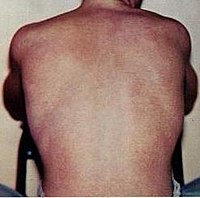
Photo from wikipedia
The Bunyavirales is one of the largest groups of RNA viruses, which encompasses many strains that are highly pathogenic to animals and humans. Severe fever with thrombocytopenia syndrome virus (SFTSV)… Click to show full abstract
The Bunyavirales is one of the largest groups of RNA viruses, which encompasses many strains that are highly pathogenic to animals and humans. Severe fever with thrombocytopenia syndrome virus (SFTSV) is an emerging tick-borne bunyavirus that causes severe disease in humans, with a high fatality rate of up to 30%. To date, the entry process of bunyavirus infection remains obscure. Here, using quantum dot (QD)-based single-particle tracking and multicolor imaging, the dynamic molecular process of SFTSV entry and penetration is systematically dissected. The results show that internalization of SFTSV into host cells is initiated by recruiting clathrin onto the cell membrane for the formation of clathrin-coated pits and further pinching off from the plasma membrane to form discrete vesicles. These vesicular carriers further deliver virions to Rab5+ early endosomes, and then to Rab7+ late endosomes. The intracellular transport of virion-carrying endocytic vesicles is dependent first on actin filaments at the cell periphery, and then on microtubules toward the cell interior. The final fusion events occur at ≈15-60 min post-entry, and are triggered by the acidic environment at ≈pH5.6 within the late endosomes. These results reveal the multistep SFTSV entry process and the dynamic virus-host interactions involved.
Journal Title: Small
Year Published: 2019
Link to full text (if available)
Share on Social Media: Sign Up to like & get
recommendations!